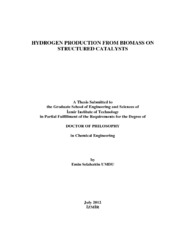Please use this identifier to cite or link to this item:
https://hdl.handle.net/11147/2930Full metadata record
| DC Field | Value | Language |
|---|---|---|
| dc.contributor.advisor | Şeker, Erol | en |
| dc.contributor.author | Umdu, Emin Selahattin | - |
| dc.date.accessioned | 2014-07-22T13:48:37Z | - |
| dc.date.available | 2014-07-22T13:48:37Z | - |
| dc.date.issued | 2012 | en |
| dc.identifier.uri | http://hdl.handle.net/11147/2930 | - |
| dc.description | Thesis (Doctoral)--Izmir Institute of Technology, Chemical Engineering, Izmir, 2012 | en |
| dc.description | Includes bibliographical references (leaves. 56-60) | en |
| dc.description | Text in English; Abstract: Turkish and English | en |
| dc.description | x, 74 leaves | en |
| dc.description.abstract | The objective of this study is to investigate crystallite-size effect for oxides of transition metals iron supported on magnesium oxide (MgO) and cerium oxide (CeO2) modified alumina (Al2O3) and the effect of the basicity and/or basic strength of support material, on activity and hydrogen selectivity in the steam reforming of glycerol. Crystallite size effect is observed for MgO and Fe on MgO/Al2O3. It is observed that larger MgO crystallites size shifts gaseous product selectivity towards CO. Further as crystallite size is becomes higher than ~5 nm for Fe for gas product selectivity decreases. Basisity has also a similar behaviour; higher basisity or presence of unidentate carbonate basic sites observed at 865 and 800 cm-1 FTIR bands for CeO2 promoted catalysts hinder CO formation and promotes CO2 formation. This also results in high activity of steam reforming. Also basisity studies shows that inorganic carboxylate catalyst site with FTIR band 1535 and 1410 cm-1 is dominantly effective for gaseous product selectivity. High total basisity do not required for high glycerol conversion, yet high total basisity results in high gaseous product selectivity. Considering studied catalysts and their catalytic activities it can be concluded that MgO and Fe modified catalysts shows better activity for syngas production due to their basic and crystalline properties. And CeO2 modified catalysts or MgO catalysts with crystallite sizes lower than 5 nm are shows better performances for CO free product | en |
| dc.language.iso | en | en_US |
| dc.publisher | Izmir Institute of Technology | en |
| dc.rights | info:eu-repo/semantics/openAccess | en_US |
| dc.subject.lcsh | Catalysts | en |
| dc.subject.lcsh | Glycerin | en |
| dc.subject.lcsh | Chemical reactions | en |
| dc.subject.lcsh | Biomass | en |
| dc.subject.lcsh | Hydrogen | en |
| dc.title | Hydrogen production from biomass on structured catalysts | en_US |
| dc.type | Doctoral Thesis | en_US |
| dc.department | Thesis (Doctoral)--İzmir Institute of Technology, Chemical Engineering | en_US |
| dc.relation.publicationcategory | Tez | en_US |
| item.languageiso639-1 | en | - |
| item.fulltext | With Fulltext | - |
| item.openairecristype | http://purl.org/coar/resource_type/c_18cf | - |
| item.openairetype | Doctoral Thesis | - |
| item.grantfulltext | open | - |
| item.cerifentitytype | Publications | - |
| Appears in Collections: | Phd Degree / Doktora | |
Files in This Item:
| File | Description | Size | Format | |
|---|---|---|---|---|
| 441216.pdf | DoctoralThesis | 4.99 MB | Adobe PDF |  View/Open |
CORE Recommender
Page view(s)
154
checked on Jul 22, 2024
Download(s)
128
checked on Jul 22, 2024
Google ScholarTM
Check
Items in GCRIS Repository are protected by copyright, with all rights reserved, unless otherwise indicated.